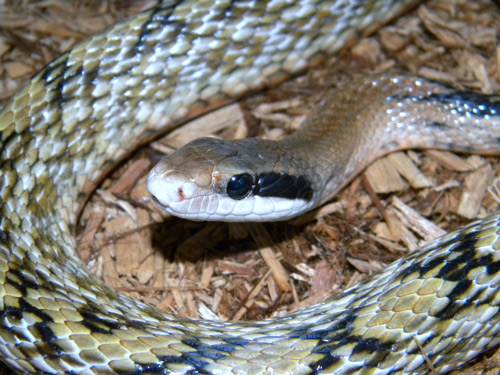Bonus content from the June 2011 REPTILES magazine article "Beauty Snakes of Southeast Asia."
There are nine beauty snake subspecies recognized: the Chinese beauty snake (Orthriophis taeniurus taeniurus), the Taiwan beauty snake (O. t. friesi), the blue beauty snake (O. t. callicyanous), Mocquard’s beauty snake (O. t. mocquardi), the Yunnan beauty snake (O. t. yunnanensis), the cave-dwelling beauty snake (O. t. ridleyi, also known as the cave racer), the Ryukyu beauty snake (O. t. schmackeri), Helfenberger’s beauty snake (O. t. helfenbergeri) and the Indonesian beauty snake (O. t. grabowskyi). The most commonly available subspecies in the reptile hobby are the Chinese, blue and Taiwan beauty snakes. Less frequent are the Mocquard’s, cave-dwelling and Yunnan beauty snakes, which I will discuss below.
Cave-Dwelling Beauty Snake
The cave-dwelling beauty snake, or cave racer as it is sometimes called, reaches an adult length of 7 to 8 feet. Orthriophis taeniurus ridleyi is unique in appearance as it is largely patternless, with the exception of the classical post-ocular eye stripe and the tail stripes. Background color varies from an ivory white to cream, with at least one locality known for a bright orange-yellow background color along the first third of the body. More slender than the blue or the Taiwan beauty snakes, it is probably the worst tempered of all the beauty snakes, too.
Mocquard’s Beauty Snake
Orthriophis t. mocquardi is similar to the Chinese beauty snake in appearance and size, with the exception that it exhibits brighter greens and yellows. The H pattern has only the faintest signs of bars connecting the legs of the H’s, and the actual legs are more boldly defined in the Mocquard’s than in the Chinese beauty snake. The Mocquard’s beauty snake also has a reputation for being less flighty than the Chinese beauty snake.

Of all the beauty snakes in the hobby, the Yunnan beauty snake is presently the most difficult to find. Photo by Ian Jessup.
Yunnan Beauty Snake
Of the beauty snakes seen in the hobby, the Yunnan beauty snake is presently the most difficult to find. It is also similar in size and appearance to the Chinese beauty snake (and thus, the Mocquard’s beauty snake), and the most striking difference in pattern is that O. t. yunnanensis has boldly outlined bowties with lightly colored centers as its dorsal pattern, as opposed to the H pattern of the other two subspecies it resembles. Additionally, the background color is generally light brown or an intermediate color resembling the Mocquard’s beauty snake or Chinese beauties background colors. As for the personality, I have found my Yunnan beauty snake to be the lapdog of all the beauty snakes I own.
Want to read the full story? Pick up the June 2011 issue of REPTILES, or subscribe to get 12 months of articles just like this.



